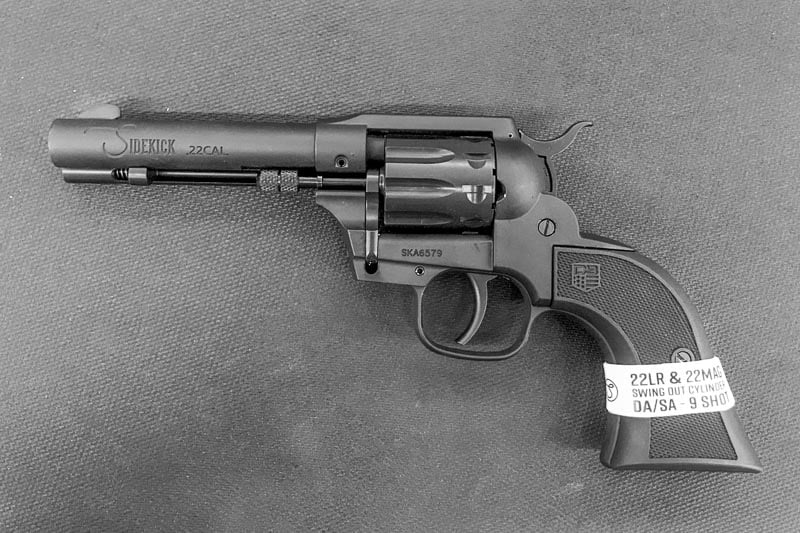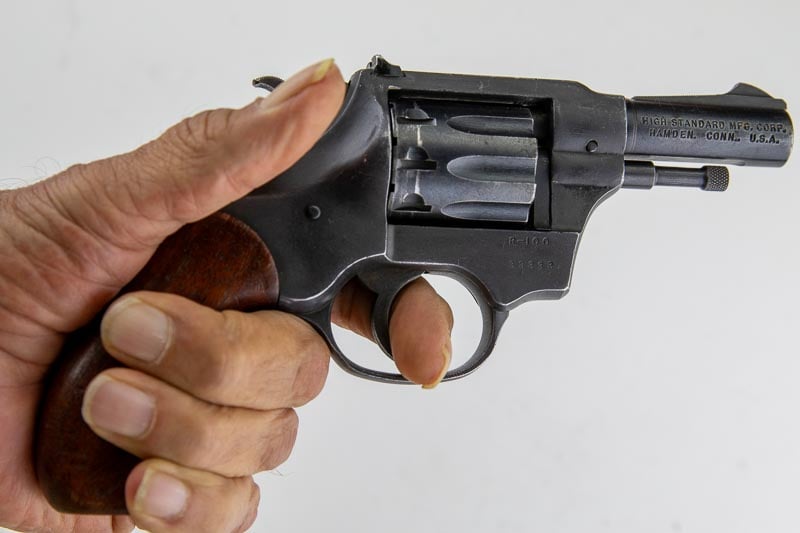1955 saw the introduction of High Standard’s first revolver, one which offered multiple innovations. It was the first lightweight aluminum .22 LR with a nine-shot swing-out cylinder. The grips were initially one-piece, held in place by a bolt through the butt. Thumb rests were even present behind the recoil shields on each side of the cylinder. The great Elmer Keith said of the High Standard Sentinel in his book “Sixguns,” “It is a very hard gun to disassemble or reassemble and this should be done only at the factory, as it is complicated…The sample tested, Serial No. 2775, with a 3-inch barrel, had excellent sights and trigger pull both single and double action…The little gun seemed to shoot very accurately and was a very good gun for fast double action practice, either aimed fire or hip shooting.”
Having owned and shot several of these over the years, I can say the Grand Old Man of shooting was right on all counts with those assessments.
The Sentinel was introduced to the world of shooters in the June 1955 issue of Guns magazine in an article by William B. Edwards titled “The First New Revolver in 50 Years.” Edwards revealed that the Sentinel was designed by Harry Sefried. Then only 33, Sefried had learned at the feet of Marsh “Carbine” Williams and would go on to become one of the most prolific small arms designers in America. It had taken him only six months to bring the Sentinel from a blank page on the drawing board to final inspection on the production line in Hamden, Connecticut.
The two-piece frame had no sideplate. The rear sight was fixed, but sat in a dovetail that allowed it to be drifted for windage. To open the cylinder one pulled forward on the ejector rod. At $34.95 original MSRP, it was in the price bracket of a top-break Harrington & Richardson 999 or Iver Johnson Trailsman but with a much better trigger pull. In “shootability” the Sentinel was close to a Smith & Wesson K-22 at less than half the S&W’s price. At only 23 ounces with four-inch barrel, thanks to its aluminum frame, the Sentinel was lighter than any of them.
Another expert of the time was quick-draw master and pioneering holster-maker Chic Gaylord. In his 1960 book “Handgunner’s Guide” Gaylord wrote, “Dollar for dollar, I think this little gun gives you more gun for your money than any other handgun sold in America today…the Hi-Standard Sentinel revolvers that I own have resulted in a bunch of smooth little nine-shooters that out-perform guns costing twice their price.”

He knew whereof he spoke: Gaylord preferred the Sentinel for his famous quick-draw demos. He wrote, “Measured by an electronic timer, before a TV studio audience, I drew and fired in four one-hundredths of a second. I cannot be too strong in my endorsement of the Hi-standard Sentinel revolver. It provides the most economical means of practice for combat shooting available today.” The cover of “Handgunner’s Guide” depicts five revolvers; two of them are from the Sentinel series including the one Gaylord is shown drawing.
Variations
From the beginning, the Sentinel was available as a snubby, a four-inch, or with a six-inch barrel. By 1957 High Standard had taken a couple more bold new steps with it. You know how you see different color handguns on dealers’ shelves today? The Sentinel started that trend with gold, baby blue, and even pink models, all with short barrels I believe, as well as blue and nickel. They didn’t catch on then and were clearly before their time.
The other was a cowboy variation introduced in 1958. Westerns were at their height of TV popularity, one reason Bill Ruger had resurrected the Peacemaker configuration with his Single Six and Blackhawks, and Colt had reintroduced the Single Action Army that had been discontinued at the beginning of WWII. High Standard’s approach was to simply make a Sentinel with a longer hammer spur, plow handle grip, and faux ejector rod housing alongside the barrel. This was named the Double Nine. It was soon followed with its own series of formats: the Longhorn with up to nine-inch-plus barrel, for example, and the Natchez with birds-head grip. It’s a Double Nine that Gaylord is whipping out of the holster on the cover of “Handgunner’s Guide.”

Even Sears, Roebuck, and Co. got into the act. Hi-Standard made these for that company with slight cosmetic changes, branded as “J.C. Higgins Ranger” revolvers. The Model 88 was more or less standard configuration, and the Double Nine with Peacemaker motif was dubbed the Model 90.
Over the years High Standard tweaked looks and model names. The Imperial had a nicer blue finish than the sandblasted look of the original Sentinel. While the series had started with plastic grips, now there was wood, both one-piece with the bolt and conventional two-piece with screws. A .22LR/.22Magnum convertible version was offered, too.
Sadly, High Standard discontinued the series in 1984. Diamondback makes a clone of the Double Nine (at least externally) called the Sidekick, but in my personal opinion, the trigger pull is nowhere near as good as on the old High Standards.

Shooting the High Standard Sentinel Series
Double action on these High Standard revolvers is a fairly heavy but very smooth single-stage pull, and quite short: those nine little chambers are close together and the cylinder doesn’t have far to turn between shots. Lockup is tight when the hammer falls. Single action is crisp and clean and runs around 3.5 pounds in pull weight. The standard Sentinel grip shape reminds me of nothing so much as the Smith & Wesson semi-square butt J-frame. The frame shape provides a built-in grip adapter: Sefried told Edwards that element was inspired by the shape of the Peacemaker.

In 2003, I was with a couple of buddies in Darnell’s Gun Shop in Bloomington, IL, and plunked down $75 and an FFL for the holster-worn Sentinel snub you see in the photos. One of my friends thought it was a piece of junk and I bet him $5 that it would put five shots under 2.5” from 25 yards. On Darnell’s range, the gun put five Remington Thunderbolts into an IPSC target’s head in a 1 1/8-inch group, reducing my cost of the gun by $5.
One nit to pick with the Sentinel was that until its upgraded R-102 series, the ejector rod lacked a return spring. Revolver shooters would eject the empties and then close the cylinder with the ratchet still to the rear, where it crashed into the side of the frame creating its own signature “idiot scratch.”

Elmer Keith wasn’t kidding about them being a bummer to take apart. This, coupled with frequent use of lubricants like 3-in-1 Oil back in the day, allowed sludge to accumulate in the mechanism. This created the false impression that the internal parts must be soft because the trigger pull degraded over time, birthing in turn the misconception that the Sentinel series were short-lived guns.
This may have led to their drop in popularity, eventually being discontinued in 1984. You won’t get a Sentinel or Double Nine for $75 now unless you rip off a widow for her late husband’s .22, but second hand these High Standard revolvers still sell for way less than their worth. From its introduction to now, 68 years later, the Sentinel series has always been a handgun “best buy.”


